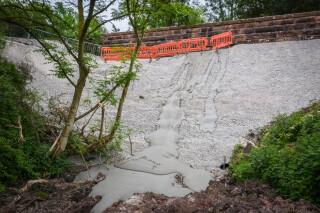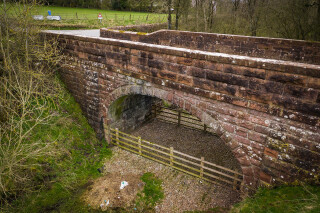Highways England is usually in the news when a major road upgrade gets the nod or is completed to great acclaim – such as the early completion of the A14 upgrade a couple of years ago. But earlier this year, the government agency found itself on the defensive following accusations that it was planning to demolish, or fill in, several hundred historic bridges that had been entrusted to its care.
The Department for Transport (DfT) gave responsibility for disused rail structures to Highways England in 2013, along with a £10m annual budget to inspect and, where necessary, repair around 3,200 bridges, tunnels and viaducts.
This article was first published in the May 2021 issue of The Construction Index magazine. Sign up online.
But in a strategic report drawn up in 2016, Highways England set out its preference to “significantly reduce the level of liability and risk to Highways England and the DfT” through a programme of demolition and infilling, which blocks the route under the structure to provide additional support. The number of structures within the Historical Railways Estate (HRE) would be reduced by 10-15% – between 320 and 480 structures – it said. And to deliver this work, Highways England awarded £254m-worth of contracts to six companies.
In January, it was revealed that 134 structures are going to be put beyond use over the next five years, with the possibility of 480 more to follow.
The announcement was met with howls of protest from campaigners who claimed that many of these structures have huge heritage and practical value and could be used for cycle paths, country walks and the provision of other local amenities.
The HRE Group, an alliance of engineers, cycling campaigners and greenway developers, claimed that no assessment was being made as to the strategic value of the affected structures for future transport provision. Moreover, Highways England was avoiding scrutiny of the normal planning processes by using permitted development powers.
By the time news got out, Highways England had already carried out a small number of bridge infilling projects. At Chilcompton in Somerset, for example, it blocked a potential extension to a line operated by the Somerset & Dorset Railway Heritage Trust, despite Mendip District Council having a policy that protects the former trackbed.
John Baxter, a member of the Trust’s board, said “We only heard about the plans second-hand and not long before permission was given to carry out the works. We regarded this as a serious oversight and we would have submitted an objection if we had received earlier notification. It has always been our intention to rebuild as much of the line towards Shepton Mallet as possible.
“Our bridge inspector, who has over 30 years’ experience with such bridges in the heritage sector, reported that the structure had a few minor defects – the sort you would expect of a bridge that was 140 years old – but there was absolutely no safety justification for what Highways England was proposing.
Baxter believes that Highways England’s priority is simply to “get rid of every liability they can without any thought whatsoever of the consequences to rail, rambling or cycling organisations that could take over the structures.
“With this huge increase in budget, it seems they’re now intent on finishing off what Dr Beeching started,” he said.
According to The HRE Group, around a third of the bridges earmarked for infilling are already proposed for reuse as part of reopened railways, heritage line extensions or footpaths and cycleways – or have identified potential to do so in the future.
Responding to the outcry, Highways England put out a statement saying that its plans to infill 115 bridges and remove 15 structures over the next five years were intended “to maintain the safety of communities living near to Historic Railway Estate structures, and the drivers who use the roads that cross them”.
“Most of the bridges earmarked for infilling are over 100 years old and were never designed to carry the weight of modern traffic,” it said.
“Local highway authorities have responsibility for applying weight restrictions, closing the roads, or restricting traffic. Around 200 of the public road bridges managed by HE/HRE have failed their most recent structural assessment (BD21) but haven’t had any restrictions implemented. Therefore, our planned infilling is the safest and most appropriate option and will maintain access across the structure.
“Ten of the 15 removals are abutments which had their bridge span removed several decades ago and no longer serve a purpose.

“We’ve contacted all local authorities affected to advise them of our plans and to see if they have any use for the structures. In addition, we have arranged for seven structures to be transferred to local authorities which aspire to use them for cycle routes.”
The HRE Group remains unconvinced, saying “fear and ignorance” is driving the “assault on railway heritage”.
It says that the BD21 structural assessment is used to determine whether or not a bridge can carry vehicles up to and including 44-tonne lorries whereas old Victorian railway bridges only have to meet BE4, a loading standard that specifies a capacity of just 24 tonnes.
“Highways England claims that none of the 200 bridges is subject to a weight restriction, but site visits to seven of those earmarked for infilling found 3-tonne limits at two of them,” it says.
The permitted development powers cited by Highways England, it argues, only apply in emergency situations and Highways England’s claim that ‘urgent safety action’ was needed was in fact an attempt to circumvent the need for planning permission.
As soon as HRE Group became aware of Highways England’s intentions it started its own appraisal of the bridges’ strategic value for future transport provision. By the middle of January it had reviewed 28 structures.
“Three are on lines submitted to the government’s ‘Restoring Your Railway Fund’, one is on a line under consideration for reinstatement by the Welsh Government, seven could be needed for new heritage lines or extensions to existing ones, whilst nine span routes on which cycle paths are proposed,” it said. One of the bridges in Scotland is legally protected under a Grade C listing.
In April, the HRE Group secured the support of the transport select committee, a cross-party group of backbench MPs. Transport committee chair Huw Merriman wrote to roads minister Charlotte Vere, copying in Highways England’s acting chief executive, Nick Harris, urging them “not to view the estate primarily as a risk to be minimised, but rather as assets to be preserved, repurposed for public benefit and enjoyed”.
He also challenged the use of permitted development powers which, in many cases, Highways England is invoking to progress work on structures that are effectively safeguarded from adverse development through policies adopted by local councils:
“The future of these historic bridges, viaducts and tunnels should be determined by an open, transparent and democratic process,” said Merriman. “Highways England should assess both the safety and value of these structures and, in non-urgent cases, apply to local authorities for planning permission, if it wishes to demolish or infill them.”
Meanwhile, HRE Group is determined to keep the pressure on Highways England and protect the ageing structures.
This article was first published in the May 2021 issue of The Construction Index magazine. Sign up online.
Graeme Bickerdike, a spokesperson for group, said: “This is what happens when you ask a company responsible for motorways to act as custodian to thousands of legacy railway structures. They seem unable to understand that taking no action after evaluating the evidence can be an entirely legitimate response to the public safety issues associated with a bridge that’s failed its BD21. It does not mean the bridge is unsafe.
“Network Rail will have structures that have also failed this assessment, but they manage the implications proportionately in collaboration with the local highway authority. What they don’t do is block the railway with a thousand tonnes of concrete.”
Read more here.. Highways England accused of rail heritage vandalism
Got a story? Email news@theconstructionindex.co.uk





